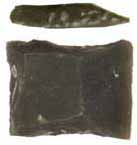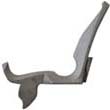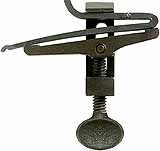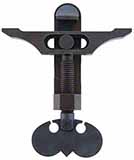Siler large left Flint Lock, by Jim Chambers
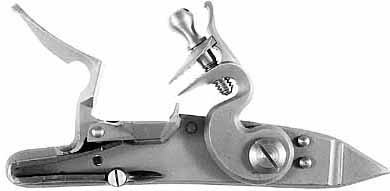
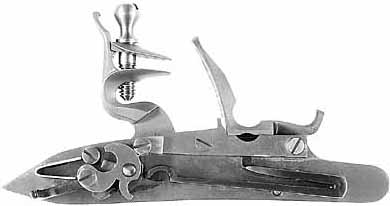
One of the first correct flint locks made for scratch builders, Siler’s flint lock is our most popular. Now made in matching right hand percussion and left hand flint and percussion, for sets and doubles!
This lock is modeled after a fine hand made original lock by the famous American gunmaker, Jacob Dickert. Few other American gunmakers made their own locks. He may have made and sold locks to others. We have examined a few rifles by Dickert, and none of these locks are exactly alike, nor were any exactly the same as the Siler lock. This lock captures the styling used on many American longrifles. Most flint locks were imported from England or Europe, for use by American gunmakers. A fine original “hand forged” flint lock, in Siler style, would make a very desirable prize for a gun collector.
We recommend our 3/4” gun flint in most large Siler locks. Track’s large Siler flint locks are tuned to allow the use of our 3/4” standard flint. Older Siler locks assembled from kits or by other suppliers may require our short 3/4” square flint. Check your half-cock clearance.
Machined from the fine parts designed by C. E. Siler, Track’s left hand Siler lock is assembled and tuned. Working parts are fitted as necessary for best action and minimum friction. Evidence of the lock maker’s skill is obvious in the tight fit of the pan, internal parts, and the smooth action. A fly detent allows set triggers, if desired.
A pan bridle arm supports the frizzen, a feature not always found on early American flint locks. Many of our best stocks are pre-inlet for our large Siler flint and percussion locks.
When ordering spare parts, be certain to specify left hand!
We recommend that you order a dozen #FLINT-ENG-6 English 3/4" gun flints, too.
This lock is shown at exact-full-size, in Track's new catalog for gunmakers and gunsmiths.
Click ADD TO CART, for same day shipment.
This lock is modeled after a fine hand made original lock by the famous American gunmaker, Jacob Dickert. Few other American gunmakers made their own locks. He may have made and sold locks to others. We have examined a few rifles by Dickert, and none of these locks are exactly alike, nor were any exactly the same as the Siler lock. This lock captures the styling used on many American longrifles. Most flint locks were imported from England or Europe, for use by American gunmakers. A fine original “hand forged” flint lock, in Siler style, would make a very desirable prize for a gun collector.
We recommend our 3/4” gun flint in most large Siler locks. Track’s large Siler flint locks are tuned to allow the use of our 3/4” standard flint. Older Siler locks assembled from kits or by other suppliers may require our short 3/4” square flint. Check your half-cock clearance.
Machined from the fine parts designed by C. E. Siler, Track’s left hand Siler lock is assembled and tuned. Working parts are fitted as necessary for best action and minimum friction. Evidence of the lock maker’s skill is obvious in the tight fit of the pan, internal parts, and the smooth action. A fly detent allows set triggers, if desired.
A pan bridle arm supports the frizzen, a feature not always found on early American flint locks. Many of our best stocks are pre-inlet for our large Siler flint and percussion locks.
When ordering spare parts, be certain to specify left hand!
This lock is shown at exact-full-size, in Track's new catalog for gunmakers and gunsmiths.
Click ADD TO CART, for same day shipment.

Siler large left Flint Lock, by Jim Chambers
English gun flint, 3/4 x 7/8", standard rifle, large Siler, L&R, most others. We are temporarily limiting purchase of this item to twelve per order. We will manually edit your order if your order exceeds that amount.
Frizzen spring screw, .51" length, 8-32 thread
Bridle, left, wax cast steel, as cast, drill in place
Frizzen, left, wax cast steel, as cast, temper after fitting
Frizzen spring, left, wax cast steel, tempered
Pan, left, wax cast steel, as cast
Lock plate, left, wax cast steel, 5.3" x .98", as cast, requires drilling and tapping
Sear spring, left, die formed steel, tempered, use 8-32 screw
Pan screw, .33" length, .237" head diameter, 8-32 threads
Tumbler screw, .50" head diameter, 8-32 thread
Fly detent, tempered, long, wax cast steel, fits right, left, large, or small Siler locks
Flint cock, left wax cast steel, 1.42" throw, tapped 1/4-20
Sear, left, tempered wax cast steel, use 8-32 screw
Tumbler, left, tempered wax cast steel, tapped 8-32
Top jaw, .78" x .88" oval, wax cast steel, .25" hole, deburred ready to install
Mainspring Vise,
deluxe English style,
for safely compressing a mainspring,
made in the U.S.A.
All sizes are nominal. Please verify with description for more information.
-
Assembled Locks - Choose Flintlock or PercussionFlintlock - Assembled Locks
-
Brand of ManufacturerJim Chambers
-
Choose Right or Left Hand LockLeft Hand GunMatching Pair for both Right/Left Hand Gun
-
Choose Style of LockAmerican Longrifles
-
Lock Parts by Flintlock ModelSiler Large - Left ( #LOCK-SL-FL-LH )
FLINT-ENG-6
English gun flint, 3/4 x 7/8", standard rifle, large Siler, L&R, most others. We are temporarily limiting purchase of this item to twelve per order. We will manually edit your order if your order exceeds that amount.
LOCK-SL-FK-L-PL
Lock plate, left, wax cast steel, 5.3" x .98", as cast, requires drilling and tapping
LOCK-SL-FL-FL
Fly detent, tempered, long, wax cast steel, fits right, left, large, or small Siler locks
LOCK-SL-FL-TJ
Top jaw, .78" x .88" oval, wax cast steel, .25" hole, deburred ready to install
TOOL-VISE-DX
Mainspring Vise,
deluxe English style,
for safely compressing a mainspring,
made in the U.S.A.
page_117.pdf
Last updated: 4/25/2012 (103 KB)
page_127.pdf
Last updated: 4/25/2012 (102 KB)
page_161.pdf
Last updated: 4/25/2012 (94 KB)
